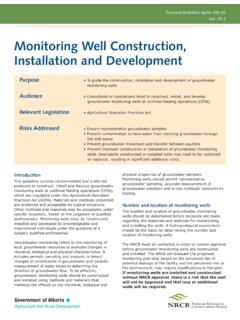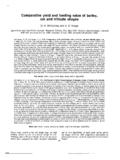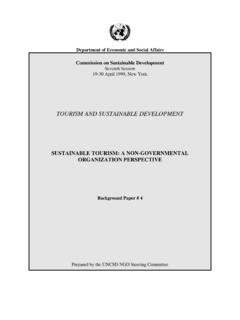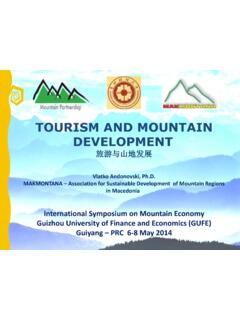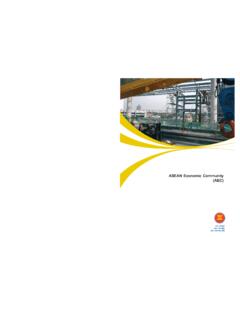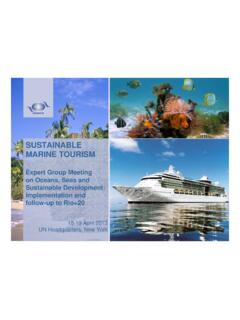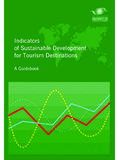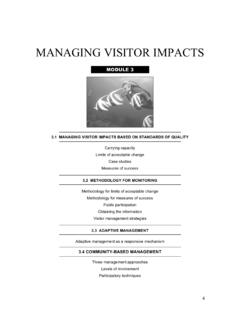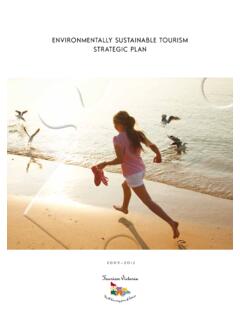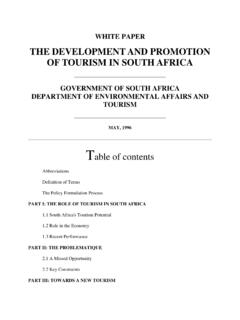Transcription of RURAL TOURISM AN OVERVIEW
1 RURAL TOURISM AN OVERVIEW OCTOBER 2010 HHuummaaiirraa IIrrsshhaadd RURAL development Division 1 TABLE OF CONTENTS Executive Summary 2 Background 4 Objectives of Study 5 Approach and Scope of Study 5 What is RURAL TOURISM ? 5 Types of RURAL TOURISM 6 Driving forces in RURAL TOURISM 7 Benefits of RURAL TOURISM 8 RURAL TOURISM in Canadian provinces some examples 11 RURAL TOURISM in other countries 15 Best practices of RURAL TOURISM 17 What makes RURAL TOURISM successful? 24 Future research and development 25 Final thoughts 28 2 EXECUTIVE SUMMARY This research provides an OVERVIEW of RURAL TOURISM , types of TOURISM , its benefits for RURAL communities and some examples of RURAL TOURISM development in Canadian provinces and other jurisdiction of the world.
2 RURAL TOURISM can be defined as the country experience which encompasses a wide range of attractions and activities that take place in agricultural or non-urban areas. Its essential characteristics include wide-open spaces, low levels of TOURISM development , and opportunities for visitors to directly experience agricultural and/or natural environments. RURAL TOURISM is not just farm-based TOURISM . It includes farm-based holidays but also comprises special interest nature holidays and ecotourism , walking, climbing and riding holidays, adventure, sport and health TOURISM , hunting and angling, educational travel, arts and heritage TOURISM , and, in some areas, ethnic TOURISM . A major form of TOURISM is agritourism, which refers to, the act of visiting a working farm or any agricultural, horticultural or agribusiness operation for the purpose of enjoyment, education, or active involvement in the activities of the farm or operation.
3 There are a wide and innovative set of RURAL /agritourism products and services available to the traveling public in all Canadian provinces. It includes agritourism, agricultural festivals, special events and festivals, the celebration of village historic sites, country fairs, agricultural travel routes that feature themes. All provincial governments, as well as local communities, are actively involved in RURAL TOURISM deployment and support agritourism networks. RURAL TOURISM is also revolutionizing businesses and prompting economic development across the globe. The US government has implemented several regional and state-wide development projects to increase the effectiveness of RURAL TOURISM /farm activities. The Australian and UK governments have also offered a wide range of products and services to promote TOURISM in the RURAL areas. TOURISM events have been found to increase business, income and employment in the region and are seen to assist with social and economic development .
4 RURAL TOURISM has many potential benefits for including employment growth, an expanded economic base, repopulation, social improvement, and revitalization of local crafts. The extent to which these benefits are realized remains the subject of much debate. Certainly, there is evidence to support the claim that, as a vehicle of economic growth and diversification, TOURISM can make an important contribution to RURAL incomes both at the level of the TOURISM operators and more widely in the local economy. As a general rule, however, RURAL communities are challenged to take full advantage of the TOURISM industry due to lack of sufficient infrastructure to support year round visitors. Therefore, in a bid to exploit the cash injection that TOURISM provides, with minimal additional resources, many RURAL communities have opted to host TOURISM events on a yearly basis.
5 However, the single yearly basis events have limited potential benefits to the communities. 3 TOURISM is not the panacea for all RURAL problems but it has number of positive attractions. It is one of the many opportunities that RURAL communities might consider to improve productivity and incomes. 4 1. BACKGROUND TOURISM is one of the largest and fastest growing industries in the world1. In both developed and developing countries, TOURISM is frequently supposed to be a viable means of raising the economic activity of regions2. Additionally, the development of a TOURISM industry has been noted to promote the destination's image, enabling the region to achieve other objectives, such as business recruitment and retention3. According to the World Travel and TOURISM Council, TOURISM generates 12% of the global gross national product and it employs around 200 million people worldwide4.
6 Tourist arrivals are estimated to reach 1 billion by 2010 and by 2020 worldwide5. The TOURISM and hospitality industry is an important contributor to Alberta s economy and is identified as a priority value-added sector in the province s economic development strategy. In 2006, TOURISM revenues were estimated to be in the order of $ billion. Approximately 10 per cent of Alberta s workforces over 180,000 people work in the TOURISM and hospitality industry. Alberta s TOURISM and hospitality industry is expected to experience strong growth over the next 10 years. Employment in the accommodation and food services segment of the industry is expected to grow on average by per cent annually over the next five years and generate almost 10,913 new jobs by 20116. One of Travel Alberta s reports show that Alberta's current TOURISM revenue is $ billion with visits in Alberta numbering million.
7 The goal is to enable industry to grow revenues to $ billion and visits to million by 20137. Given the expected growth of TOURISM there is a great optimism for RURAL TOURISM . Numerous agencies and academic researchers have identified TOURISM as a potential economic development tool, particularly for RURAL communities8. RURAL TOURISM is increasingly being used as a development strategy to improve the social and economic well being of RURAL areas. RURAL TOURISM encompasses a huge range of activities, natural or manmade attractions, amenities and facilities, transportation, marketing and information systems9. RURAL TOURISM is very diverse and fragmented in terms of operational structures, activities, markets and operating environments10. RURAL TOURISM is not just farm-based TOURISM . It includes farm-based holidays but also comprises special interest nature holidays and ecotourism , walking, climbing and riding holidays, 1 Edgell 1990; Lo & Lai 2003 2 Hall 1994 3 Barkley 1993 4 WTTC, 1995 5 Pearce, 1995 6 Statistics Canada and Alberta TOURISM , Parks, Recreation and Culture, Canadian Business Patterns Business Register March 2006, Statistics Canada, Total TOURISM Sector and Labour Force Survey 2006, Statistics Canada 7 Travel Alberta Business Strategy 2010-2013.
8 8 Wilkerson 1996; Prosser 2000 9 Sharpley & Sharpley, 1997 10 Roberts & Hall, 2001, citing Pearce, 1989) 5 adventure, sport and health TOURISM , hunting and angling, educational travel, arts and heritage TOURISM , and, in some areas, ethnic TOURISM . 2. OBJECTIVES OF STUDY The objectives of this study are as follows: To collect information on RURAL TOURISM and to identify different types of RURAL TOURISM . To provide an OVERVIEW on driving forces and benefits of RURAL TOURISM . To review TOURISM development in Canadian provinces and other jurisdictions. To identify issues for future research and development for RURAL TOURISM . 3. APPROACH AND SCOPE OF STUDY This study draws on previous research available on websites and other documents. The research is not limited to Alberta but also reviews TOURISM development in other Canadian provinces and countries.
9 The study focuses on types of TOURISM , driving forces in RURAL TOURISM , its benefits and what makes RURAL TOURISM successful. It provides some examples of RURAL TOURISM in Canadian provinces and other countries. The study also provides information on some best practices from other countries representing different geographic regions and stages of TOURISM development . The study also highlights some areas for future research and development for RURAL TOURISM . 4. WHAT IS RURAL TOURISM ? RURAL TOURISM can be defined as the country experience which encompasses a wide range of attractions and activities that take place in agricultural or non-urban areas. Its essential characteristics include wide-open spaces, low levels of TOURISM development , and opportunities for visitors to directly experience agricultural and/or natural Consequently, RURAL TOURISM in its purest form should be12: o Located in RURAL areas.
10 O Functionally RURAL built upon the RURAL world s special features of small-scale enterprise, open space, contact with nature and the natural world, heritage, traditional societies and traditional practices. o RURAL in scale both in terms of buildings and settlements and, therefore, usually small-scale. o Traditional in character, growing slowly and organically, and connected with local families. It will often be very largely controlled locally and developed for the long term good of the area. 11 Ibid. 12 Lane B., (1994, What is RURAL TOURISM , Journal of sustainable TOURISM Volume 2, 6 5. TYPES OF RURAL TOURISM TOURISM is synthesized from mass and alternative TOURISM . Mass TOURISM is characterized by large numbers of people seeking culture holidays in popular resort destinations.)
